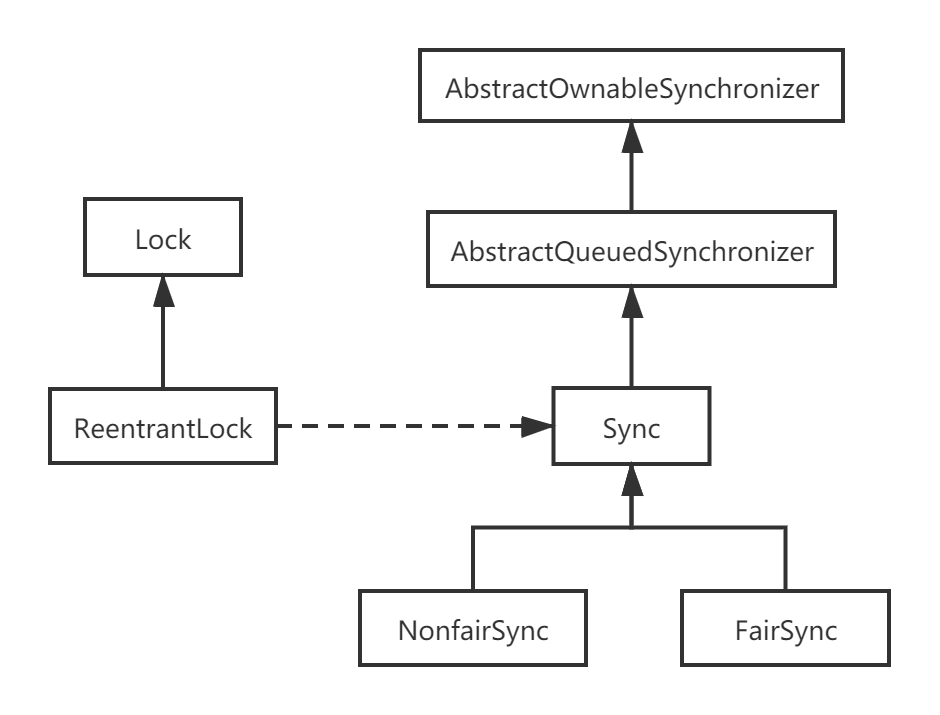AQS源码解读(三)——ReentrantLock原理详解(Sync、NonfairSync、FairSync)
天青色等烟雨,而我在等你,微信公众号搜索:徐同学呀,持续更新肝货,快来关注我,和我一起学习吧~
更多JUC源码解读系列文章请持续关注JUC源码解读文章目录JDK8 !
文章目录
- 一、前言
- 二、ReentrantLock基本结构
- 三、锁的公平性
- 四、锁的获取与释放
- 1、ReentrantLock#lock
- (1)ReentrantLock.NonfairSync
- (2)ReentrantLock.FairSync
- 2、ReentrantLock#lockInterruptibly
- 3、ReentrantLock#tryLock
- 4、ReentrantLock#unlock
- 五、总结
- 文末有彩蛋
一、前言
ASQ实现的是一套通用的模板,并不能完全直接应用于实际并发生产中,ReentrantLock就是根据AQS实现的互斥可重入锁。ReentrantLock和synchronized类似,互斥、阻塞、可重入,不同之处在于synchronized基于Java语法层面实现隐式加锁和释放锁,ReentrantLock基于API层面实现显式加锁和释放锁。
ReentrantLock实现了接口Lock,相较于synchronized,对锁的操作更灵活可控,同时根据不同的环境实现了公平锁和非公平锁。
二、ReentrantLock基本结构
ReentrantLock本身没有什么代码逻辑,实现的方法调用的是Sync的模板方法,所以锁机制的所有实现逻辑都在ReentrantLock的内部类Sync中。Sync继承自AbstractQueuedSynchronizer,其还有两个子类NonfairSync和FairSync,分别具体实现非公平和公平情况下加锁的逻辑。如下是ReentrantLock的类关系图:
public class ReentrantLock implements Lock, java.io.Serializable {private static final long serialVersionUID = 7373984872572414699L;/** Synchronizer providing all implementation mechanics *///sync同步器提供所有的实现机制private final Sync sync;/** * Base of synchronization control for this lock. Subclassed * into fair and nonfair versions below. Uses AQS state to * represent the number of holds on the lock. */abstract static class Sync extends AbstractQueuedSynchronizer {abstract void lock();... ...}static final class NonfairSync extends Sync {final void lock() { }... ...}static final class FairSync extends Sync {final void lock() { }... ...}... ...}
三、锁的公平性
ReentrantLock默认情况下提供非公平锁,同时也可以在实例化的时候指定锁公平性。
public ReentrantLock() {sync = new NonfairSync();}public ReentrantLock(boolean fair) {sync = fair ? new FairSync() : new NonfairSync();}
何为公平和非公平,例如实际生活中的排队,新来的人按规矩排在队尾是公平,插队就是非公平。对于锁也是同样的道理,新来线程排在阻塞队列队尾是公平,一上来就抢锁是非公平。不同于现实生活,ReentrantLock默认非公平锁是为了减少线程间的切换,从而提高效率。
四、锁的获取与释放
ReentrantLock锁的获取分别实现了不可中断获取锁lock,尝试获取锁tryLock(获取成功返回true,获取失败返回false),可中断获取锁lockInterruptibly;锁的释放unlock很简单,直接调用的AQS的模板方法release,不需要区分公平性。
1、ReentrantLock#lock
ReentrantLock#lock调用了sync.lock(),Sync中lock()是一个抽象函数,具体的实现在其子类NonfairSync和FairSync中。
public void lock() {sync.lock();}abstract static class Sync extends AbstractQueuedSynchronizer {/** * Performs {@link Lock#lock}. The main reason for subclassing * is to allow fast path for nonfair version. */abstract void lock();}
(1)ReentrantLock.NonfairSync
ReentrantLock.NonfairSync#lock实现了Sync中的抽象方法lock,其非公平性体现在,一上来就抢锁设置statecompareAndSetState(0, 1),如果抢锁成功就设置当前线程为持有独占锁的线程setExclusiveOwnerThread(Thread.currentThread())。
static final class NonfairSync extends Sync {private static final long serialVersionUID = 7316153563782823691L;/** * Performs lock. Try immediate barge, backing up to normal * acquire on failure. */final void lock() {//非公平,直接抢锁if (compareAndSetState(0, 1))//抢成功,设置当前独占锁的线程为当前线程setExclusiveOwnerThread(Thread.currentThread());else//没有抢到acquire(1);}protected final boolean tryAcquire(int acquires) {return nonfairTryAcquire(acquires);}}
如果一上来抢锁失败则进入AQS的模板方法acquire(1),acquire(1)中还会再进行一次抢锁tryAcquire,抢锁失败才进入AQS队列操作acquireQueued(addWaiter(Node.EXCLUSIVE), arg)。(acquire详解请看拙作《AQS源码解读——从acquireQueued探索独占锁实现原理,如何阻塞?如何唤醒?》)
//AbstractQueuedSynchronizer#acquirepublic final void acquire(int arg) {//若没有抢到锁,则进入等待队列if (!tryAcquire(arg) &&acquireQueued(addWaiter(Node.EXCLUSIVE), arg))//自己中断自己selfInterrupt();}
加锁的通用模板acquire()已经在AQS中实现,子类只需要实现tryAcquire即可。NonfairSync#tryAcquire调用了父类的Sync#nonfairTryAcquire。具体逻辑如下:
- 查看当前state,是否有线程持有锁,没有
state=0则继续抢锁。 有线程持有锁,判断持有锁的线程是否是当前线程,是就重入。
//ReentrantLock.Sync#nonfairTryAcquire
final boolean nonfairTryAcquire(int acquires) {final Thread current = Thread.currentThread();int c = getState();if (c == 0) {//若此时锁空着,则再次尝试抢锁if (compareAndSetState(0, acquires)) {setExclusiveOwnerThread(current);return true;}}//若当前持锁线程是当前线程(重入性)else if (current == getExclusiveOwnerThread()) {int nextc = c + acquires;if (nextc < 0) // overflowthrow new Error("Maximum lock count exceeded");//重入setState(nextc);return true;}return false;
}
(2)ReentrantLock.FairSync
FairSync和NonfairSync的主要区别在于,FairSync不会一上来就抢锁,而是先判断队列中是否有其他线程在等待锁,没有再抢锁。
代码的模板逻辑和NonfairSync类似,区别在于FairSync中tryAcquire的实现。
static final class FairSync extends Sync {private static final long serialVersionUID = -3000897897090466540L;final void lock() {acquire(1);}/** * Fair version of tryAcquire. Don't grant access unless * recursive call or no waiters or is first. */protected final boolean tryAcquire(int acquires) {final Thread current = Thread.currentThread();int c = getState();if (c == 0) {//是否有线程在等待锁,没有则抢锁if (!hasQueuedPredecessors() &&compareAndSetState(0, acquires)) {setExclusiveOwnerThread(current);return true;}}//如果当前线程已经持有该锁,重入else if (current == getExclusiveOwnerThread()) {int nextc = c + acquires;if (nextc < 0)throw new Error("Maximum lock count exceeded");setState(nextc);return true;}return false;}}
FairSync的公平性主要体现在tryAcquire判断当前没有线程持有锁时,不会立即去抢锁,而是判断AQS队列中是否有其他线程也在等待锁,没有才去抢锁。如果有线程正持有锁,判断是否是当前线程,是则重入。
public final boolean hasQueuedPredecessors() {// The correctness of this depends on head being initialized// before tail and on head.next being accurate if the current// thread is first in queue.Node t = tail; // Read fields in reverse initialization orderNode h = head;Node s;return h != t &&((s = h.next) == null || s.thread != Thread.currentThread());}
2、ReentrantLock#lockInterruptibly
lock是不可中断锁,lockInterruptibly是可中断锁,其直接调用了AQS的模板方法acquireInterruptibly。
public void lockInterruptibly() throws InterruptedException {sync.acquireInterruptibly(1);}
acquireInterruptibly和doAcquireInterruptibly代码中分别响应中断抛出异常InterruptedException。
(acquireInterruptibly和doAcquireInterruptibly详解请看拙作《AQS源码解读——从acquireQueued探索独占锁实现原理,如何阻塞?如何唤醒?》)
3、ReentrantLock#tryLock
tryLock尝试获取锁,调用的是sync.nonfairTryAcquire(1),不会涉及到AQS队列操作,获取锁成功返回true,失败返回false。
public boolean tryLock() {return sync.nonfairTryAcquire(1);}
tryLock还有一个重载方法,可传入一个超时时长timeout和一个时间单位TimeUnit,超时时长会被转为纳秒级。
public boolean tryLock(long timeout, TimeUnit unit)throws InterruptedException {return sync.tryAcquireNanos(1, unit.toNanos(timeout));}
tryLock(long timeout, TimeUnit unit)直接调用了AQS的模板方法tryAcquireNanos,也具备了响应中断,超时获取锁的功能:
- 若一开始获取锁
tryAcquire失败则进入AQS同步队列doAcquireNanos。 - 进入同步队列后自旋1000纳秒,还没有获取锁且判断应该阻塞,则会阻塞一定时长。
- 超时时长到线程自动唤醒,再自旋还没获取锁,且判断超时则返回false。
(tryAcquireNanos详解请看拙作《AQS源码解读——从acquireQueued探索独占锁实现原理,如何阻塞?如何唤醒?》)
4、ReentrantLock#unlock
ReentrantLock释放锁的过程没有区分公平性,调用的是AQS的模板方法release(),其基本逻辑如下:
- 释放锁
tryRelease。 唤醒后继节点
unparkSuccessor。(unparkSuccessor详解请看拙作《AQS源码解读——从acquireQueued探索独占锁实现原理,如何阻塞?如何唤醒?》)//ReentrantLock
public void unlock() {sync.release(1);
}
//AbstractQueuedSynchronizer
public final boolean release(int arg) {if (tryRelease(arg)) {Node h = head;if (h != null && h.waitStatus != 0)//释放锁成功后唤醒head后继节点。unparkSuccessor(h);return true;}return false;
}
释放锁的逻辑由ReentrantLock实现,释放锁之后唤醒后继由AQS负责。释放锁的代码ReentrantLock.Sync#tryRelease基本逻辑如下:
- 判断持有锁的线程是否是当前线程,不是当前线程则抛出异常。
- 判断释放之后的state==0,等于0说明完全释放锁,将持锁的线程设置为null。
- 修改state,因为是排它锁,只有当前线程才会走到这里,所以是线程安全的。
注:如果是当前线程多次重入,releases=1是不能完全释放锁的,free=false,也不会唤醒后继节点。
//ReentrantLock.Sync#tryReleaseprotected final boolean tryRelease(int releases) {//释放锁之后的state值int c = getState() - releases;if (Thread.currentThread() != getExclusiveOwnerThread())//不是当前线程,不能unLock 抛异常throw new IllegalMonitorStateException();boolean free = false;if (c == 0) {//每次减一,c = 0,证明没有线程持有锁了,可以释放了free = true;setExclusiveOwnerThread(null);}setState(c); //排它锁,只有当前线程才会走到这,是线程安全的 修改statereturn free;}
五、总结
ReentrantLock通过AQS实现了互斥锁的逻辑,核心模板代码都在AQS中,ReentrantLock中只需要实现tryAcquire和tryRelease即可。ReentrantLock是互斥锁且可重入。ReentrantLock实现了不可中断获取锁,可中断获取锁,可超时获取锁。ReentrantLock获取锁有公平与非公平之分,释放锁没有。
PS: 如若文章中有错误理解,欢迎批评指正,同时非常期待你的评论、点赞和收藏。我是徐同学,愿与你共同进步!
文末有彩蛋
《Java开发手册(泰山版)》中对Lock的使用做了几点强制的规范:
【强制】在使用阻塞等待获取锁的方式中,必须在 try 代码块之外,并且在加锁方法与 try 代
码块之间没有任何可能抛出异常的方法调用,避免加锁成功后,在 finally 中无法解锁。
说明一:如果在 lock 方法与 try 代码块之间的方法调用抛出异常,那么无法解锁,造成其它线程无法成功
获取锁。
说明二:如果 lock 方法在 try 代码块之内,可能由于其它方法抛出异常,导致在 finally 代码块中,unlock
对未加锁的对象解锁,它会调用 AQS 的 tryRelease 方法(取决于具体实现类),抛出
IllegalMonitorStateException 异常。
说明三:在 Lock 对象的 lock 方法实现中可能抛出 unchecked 异常,产生的后果与说明二相同。
正例:
Lock lock = new XxxLock();// ...lock.lock();try {doSomething();doOthers();} finally {lock.unlock();}反例:
Lock lock = new XxxLock();// ...try {// 如果此处抛出异常,则直接执行 finally 代码块doSomething();// 无论加锁是否成功,finally 代码块都会执行lock.lock();doOthers();} finally {lock.unlock();}【强制】在使用尝试机制来获取锁的方式中,进入业务代码块之前,必须先判断当前线程是否
持有锁。锁的释放规则与锁的阻塞等待方式相同。
说明:Lock 对象的 unlock 方法在执行时,它会调用 AQS 的 tryRelease 方法(取决于具体实现类),如果
当前线程不持有锁,则抛出 IllegalMonitorStateException 异常。
正例:
Lock lock = new XxxLock();// ...boolean isLocked = lock.tryLock();if (isLocked) {try {doSomething();doOthers();} finally {lock.unlock();}}





























还没有评论,来说两句吧...